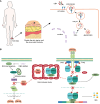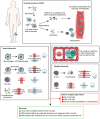Antiviral immunity of severe fever with thrombocytopenia syndrome: current understanding and implications for clinical treatment
- PMID: 38646523
- PMCID: PMC11026560
- DOI: 10.3389/fimmu.2024.1348836
Antiviral immunity of severe fever with thrombocytopenia syndrome: current understanding and implications for clinical treatment
Abstract
Dabie Banda virus (DBV), a tick-borne pathogen, was first identified in China in 2009 and causes profound symptoms including fever, leukopenia, thrombocytopenia and multi-organ dysfunction, which is known as severe fever with thrombocytopenia syndrome (SFTS). In the last decade, global incidence and mortality of SFTS increased significantly, especially in East Asia. Though previous studies provide understandings of clinical and immunological characteristics of SFTS development, comprehensive insight of antiviral immunity response is still lacking. Here, we intensively discuss the antiviral immune response after DBV infection by integrating previous ex- and in-vivo studies, including innate and adaptive immune responses, anti-viral immune responses and long-term immune characters. A comprehensive overview of potential immune targets for clinical trials is provided as well. However, development of novel strategies for improving the prognosis of the disease remains on challenge. The current review may shed light on the establishment of immunological interventions for the critical disease SFTS.
Keywords: SFTS; antiviral immunity; clinical treatment; immune cells; immune response.
Copyright © 2024 Niu, Liu, Huang, Liu, Cheng, Liu, Ning and Chen.
Conflict of interest statement
The authors declare that the research was conducted in the absence of any commercial or financial relationships that could be construed as a potential conflict of interest.
Figures


Similar articles
-
Recent research advances in the development of Dabie Banda virus vaccines.PLoS Negl Trop Dis. 2024 Aug 29;18(8):e0012411. doi: 10.1371/journal.pntd.0012411. eCollection 2024 Aug. PLoS Negl Trop Dis. 2024. PMID: 39207951 Free PMC article. Review.
-
Overview of the immunological mechanism underlying severe fever with thrombocytopenia syndrome (Review).Int J Mol Med. 2022 Sep;50(3):118. doi: 10.3892/ijmm.2022.5174. Epub 2022 Jul 20. Int J Mol Med. 2022. PMID: 35856413 Free PMC article. Review.
-
Unraveling the Underlying Interaction Mechanism Between Dabie bandavirus and Innate Immune Response.Front Immunol. 2021 May 27;12:676861. doi: 10.3389/fimmu.2021.676861. eCollection 2021. Front Immunol. 2021. PMID: 34122440 Free PMC article. Review.
-
Immune escape mechanisms of severe fever with thrombocytopenia syndrome virus.Front Immunol. 2022 Jul 28;13:937684. doi: 10.3389/fimmu.2022.937684. eCollection 2022. Front Immunol. 2022. PMID: 35967309 Free PMC article. Review.
-
Early-Warning Immune Predictors for Invasive Pulmonary Aspergillosis in Severe Patients With Severe Fever With Thrombocytopenia Syndrome.Front Immunol. 2021 May 7;12:576640. doi: 10.3389/fimmu.2021.576640. eCollection 2021. Front Immunol. 2021. PMID: 34025635 Free PMC article.
Cited by
-
Advances in research on severe fever with thrombocytopenia syndrome virus.Front Microbiol. 2025 Jul 23;16:1622394. doi: 10.3389/fmicb.2025.1622394. eCollection 2025. Front Microbiol. 2025. PMID: 40771693 Free PMC article. Review.
-
Recent research advances in the development of Dabie Banda virus vaccines.PLoS Negl Trop Dis. 2024 Aug 29;18(8):e0012411. doi: 10.1371/journal.pntd.0012411. eCollection 2024 Aug. PLoS Negl Trop Dis. 2024. PMID: 39207951 Free PMC article. Review.
References
-
- Kuhn JH, Adkins S, Alioto D, Alkhovsky SV, Amarasinghe GK, Anthony SJ, et al. . 2020 Taxonomic update for phylum negarnaviricota (Riboviria: Orthornavirae), including the large orders bunyavirales and mononegavirales. Arch Virol. (2020) 165:3023–72. doi: 10.1007/s00705-020-04731-2 - DOI - PMC - PubMed
Publication types
MeSH terms
LinkOut - more resources
Full Text Sources

